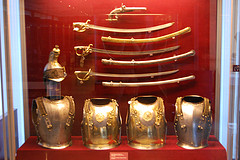

Location: Vasilssis Soflas and Rizari, Illsia, Athens
Tel.
210 725 2975
Subway: Evangelismos
Tram train: 3, 7, 8, 13
Open: 9am- 2pm Tue- Sat, 9:30am- 2pm Sun
Closed: public
holidays
Official site
The War Museum is the central military history museum in Greece and houses the historical weapons collection of the Greek Ministry of Defense.
In 1964, the Greek government at the time decided to establish a
central museum on the military history of Greece. The
construction was decided by the military junta. The museum was
founded in 1969 and construction began in 1972. The building was
designed by Thoukydidis Valentis. The building, which was modern
at the time, shows some architectural influences of the Bauhaus
style.
The museum was inaugurated on July 18, 1975 by the
President of the Greek Republic, Konstantinos Tsatsos, together
with the Minister of Defense, Evangelos Averoff.
The
museum aims to collect and preserve objects and documents
relating to warlike or military conflicts in the history of
Greece and to make them accessible to the public in documented
form. It also serves as a central research facility on the
history of war in Greece, from the early Bronze Age to the
present day.
The Athens War Museum now has branches in
Thessaloniki, Kalamata, Nafplio, Chania, Tripoli and Chalkida,
bringing together collections and enabling modern museum
educational work.
The museum is in a prominent location on Vassilis Sophia Avenue
in the center of Athens.
General Napoleon Zervas' house
in the Metaxourgeio district also functions as an annex to the
museum.
The museum's public exhibition area is used to present the
military conflicts in which Greece has been involved throughout
history.
In the educational field, the museum is
regularly used as a destination for school excursions.
The exhibition is divided into ten rooms:
Room 1 - Weapons of
the Stone Age and Bronze Age, with a focus on Mycenae
Room 2
- Antiquity
Room 3 - Byzantium
Room 4 - The Franks
Rooms 5 and 6 The Greek War of Independence
Room 7 - The
early Greek state
Room 8 - The Balkan Wars 1912-1913
Room
9 - The Balkan Wars and the First World War
Room 10 - Second
World War and the Occupation Period
There are also
exhibits from the Greek Expeditionary Force in Korea and a room
with exhibits related to the EOKA and the Turkish invasion of
Cyprus in 1974.
Asian and oriental weapons are presented
in display cases.
The former Greek artillery officer,
Petros Saroglou, bequeathed an extensive collection of weapons
to the museum. Exhibits from various countries of origin can be
seen, some of which are considered very rare and therefore
valuable. The weapons of the Greek Revolution are particularly
important for the museum.
Larger artillery weapons from
various eras are presented in the museum's outdoor area. These
are complemented by former aircraft of the Greek Air Force, of
which the museum association owns several examples (e.g. the
Starfighter) or which are of particular importance to the museum
in Athens (e.g. "Daidalos"). As a result of the merger of the
museums, some important aircraft were transferred to the Greek
Air Force Museum. The rare weapons in the outdoor area include
two of only five surviving armored vehicles.
The military history archive includes a collection of 400 maps from the 15th century and personal files, correspondence, military diaries and troop orders from the 19th and 20th centuries. The photo archive has just over twenty thousand photographs from the period from 1897 to the present day. The museum's library, founded in 1976, contains more than 25,000 volumes of Greek and foreign publications on predominantly military topics. The available maps and engravings mainly cover the historical and current Greek state.
The scientific area of the War Museum has a research and study
department and a restoration department with five workshops. The
workshops serve to preserve and maintain five different areas:
metals, weapons, maps, written documents and paintings.
A
conference center with a lecture hall, a training room, an
atrium and the associated foyer is available for the
presentation of research results.
The exhibition operation in the permanent exhibition is kept
attractive by regular exhibitions on complementary topics.
Under the motto "Design for everyone", a special exhibition
on the design of everything from simple aids to prostheses was
shown in 2004.